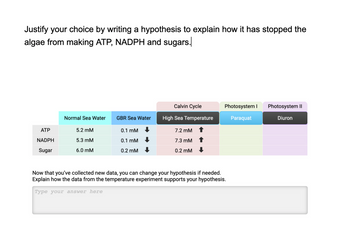
Biochemistry
9th Edition
ISBN: 9781319114671
Author: Lubert Stryer, Jeremy M. Berg, John L. Tymoczko, Gregory J. Gatto Jr.
Publisher: W. H. Freeman
expand_more
expand_more
format_list_bulleted
Question

Transcribed Image Text:Justify your choice by writing a hypothesis to explain how it has stopped the
algae from making ATP, NADPH and sugars.
ATP
NADPH
Sugar
Normal Sea Water
5.2 mM
5.3 MM
6.0 mM
GBR Sea Water
0.1 mM
0.1 mM
0.2 mM
Calvin Cycle
High Sea Temperature
7.2 mM ↑
7.3 mM
0.2 mM
Photosystem I Photosystem II
Paraquat
Diuron
Now that you've collected new data, you can change your hypothesis if needed.
Explain how the data from the temperature experiment supports your hypothesis.
Type your answer here
Expert Solution
This question has been solved!
Explore an expertly crafted, step-by-step solution for a thorough understanding of key concepts.
This is a popular solution
Trending nowThis is a popular solution!
Step by stepSolved in 3 steps

Knowledge Booster
Similar questions
- QUESTION 14 Fixation of carbon dioxide in the Calvin Cycle: Occur in the stroma of the chloroplasts O Occur in the thylakoid membrane within the grana O Occur in the thylakoid membrane O Occur in the thylakoid membrane and in the grana QUESTION 15 What is the product or products of the light reactions in photosynthesis? ATP and carbon dioxide O Glucose O Glucose, water and carbon dioxide ATP and NADPH Click Save and Submit to save and submit. Click Save All Answers to save all answers. hparrow_forwardDATA Table 2 Table 3 Absorbance Absorbance Absorbance Time Rate of unboiled unboiled boiled Chloroplast (min) photosynthesis light dark light 143 153 Unboiled . 0003 5 | .156 •160 .143 Dark 000 74 10 -184 .152 Boiled -. 00062 15 .]53 161 . 140 20 .148 139 QUESTIONS 1. IS THERE EVIDENCE THAT CHLOROPLASTS WERE ABLE TO REDUCE DPIP IN THIS EXPERIMENT? EXPLAIN. 2. Were chloroplasts able to reduce DPIP when kept in the dark? Explain. 3. Were boiled chloroplasts able to reduce DPIP ? Explain. 4. What conclusions can you make about the photosynthetic activity of spinach?arrow_forwardcan humans absorb light and inhale gas and make sugar?arrow_forward
- Match the following. 3 Photosynthesis begins with the 8: which use the energy of ↓ that are absorbed by ✓ T A reactions N splits R into O in the P within this is a reaction center housed in ↓ Q that $ 4 excites S U used by the found in the % 5 Which occurs in the which uses the energy of which passes it to to pump gradient is used by J K 9 F5 to make H L 6 B F6 M to make to reduce used by if extra ATP is needed used by & 7 G occurs which fixes C za D ✓ F E from the to make 8 F8 9arrow_forward15arrow_forwardYou are culturing 2 algal species. Species A has a maximum photosynthetic output of 8 mg C mg-1 chl a h-1 and a half saturation constant of 20 µE m-2 s-1. Species B reaches a maximum photosynthetic output of 4 mg C mg-1 chl a h-1 and has half saturation constant of 18 µE m-2 s-1. Which species will be growing faster at a PAR light intensity of 80 µE m-2 s-1? Why?arrow_forward
- For each of the conditions listed below, would the rate of photosynthesis increase, decrease, or stay the same? For your answer, write the number of the condition then "increase", "decrease" or "stay the same". 1. cellular glucose concentration increases 2 light level increases from low to moderate 3. cellular NADH concentration decreases 4.. CO2 concentration increases from low to moderatearrow_forwardFully answer any one of the two questions below using all relative terms: Describe the reactants and products associated with the yeast fermentation experiment. Yeast were exposed to glucose, sucrose, fructose and starch. What was the dependent variable in this experiment? What was the independent variable? List three controlled variables from this experiment. OR Identify the photosynthetic pigments in plants and describe the colors/wavelengths of the electromagnetic spectrum they absorb. Describe paper chromatography and how this was used to separate the pigments.arrow_forward
arrow_back_ios
arrow_forward_ios
Recommended textbooks for you
 BiochemistryBiochemistryISBN:9781319114671Author:Lubert Stryer, Jeremy M. Berg, John L. Tymoczko, Gregory J. Gatto Jr.Publisher:W. H. Freeman
BiochemistryBiochemistryISBN:9781319114671Author:Lubert Stryer, Jeremy M. Berg, John L. Tymoczko, Gregory J. Gatto Jr.Publisher:W. H. Freeman Lehninger Principles of BiochemistryBiochemistryISBN:9781464126116Author:David L. Nelson, Michael M. CoxPublisher:W. H. Freeman
Lehninger Principles of BiochemistryBiochemistryISBN:9781464126116Author:David L. Nelson, Michael M. CoxPublisher:W. H. Freeman Fundamentals of Biochemistry: Life at the Molecul...BiochemistryISBN:9781118918401Author:Donald Voet, Judith G. Voet, Charlotte W. PrattPublisher:WILEY
Fundamentals of Biochemistry: Life at the Molecul...BiochemistryISBN:9781118918401Author:Donald Voet, Judith G. Voet, Charlotte W. PrattPublisher:WILEY BiochemistryBiochemistryISBN:9781305961135Author:Mary K. Campbell, Shawn O. Farrell, Owen M. McDougalPublisher:Cengage Learning
BiochemistryBiochemistryISBN:9781305961135Author:Mary K. Campbell, Shawn O. Farrell, Owen M. McDougalPublisher:Cengage Learning BiochemistryBiochemistryISBN:9781305577206Author:Reginald H. Garrett, Charles M. GrishamPublisher:Cengage Learning
BiochemistryBiochemistryISBN:9781305577206Author:Reginald H. Garrett, Charles M. GrishamPublisher:Cengage Learning Fundamentals of General, Organic, and Biological ...BiochemistryISBN:9780134015187Author:John E. McMurry, David S. Ballantine, Carl A. Hoeger, Virginia E. PetersonPublisher:PEARSON
Fundamentals of General, Organic, and Biological ...BiochemistryISBN:9780134015187Author:John E. McMurry, David S. Ballantine, Carl A. Hoeger, Virginia E. PetersonPublisher:PEARSON

Biochemistry
Biochemistry
ISBN:9781319114671
Author:Lubert Stryer, Jeremy M. Berg, John L. Tymoczko, Gregory J. Gatto Jr.
Publisher:W. H. Freeman

Lehninger Principles of Biochemistry
Biochemistry
ISBN:9781464126116
Author:David L. Nelson, Michael M. Cox
Publisher:W. H. Freeman

Fundamentals of Biochemistry: Life at the Molecul...
Biochemistry
ISBN:9781118918401
Author:Donald Voet, Judith G. Voet, Charlotte W. Pratt
Publisher:WILEY

Biochemistry
Biochemistry
ISBN:9781305961135
Author:Mary K. Campbell, Shawn O. Farrell, Owen M. McDougal
Publisher:Cengage Learning

Biochemistry
Biochemistry
ISBN:9781305577206
Author:Reginald H. Garrett, Charles M. Grisham
Publisher:Cengage Learning

Fundamentals of General, Organic, and Biological ...
Biochemistry
ISBN:9780134015187
Author:John E. McMurry, David S. Ballantine, Carl A. Hoeger, Virginia E. Peterson
Publisher:PEARSON